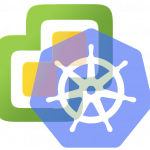I’d like to start this post saying that this is my 4th attendance to one of the important events in the world focused on virtualization and cloud: VMworld 2019. From 4th to 7th November, a series of learning sessions, laboratories, discussion panels and a lot of community moments are going to happen in the big and wonderful city of Barcelona.
More Kubernetes…
Getting a look at the agenda one of the topics of the year is Kubernetes. In fact, after the official announcement of the Project Pacific, VMware is definitely changing its path from the VM centric vision to the container orchestration. This means that finally, vCenter would be the new way to orchestrate VM and the Containers with a single pane of glass. But there’s more!

Kubernetes showed a great attraction to developers, which are more and more moving their application to the Cloud Native space: write your code, wrap in a container separating the execution process from the data persistence, and finally with a simple deploy process, the application will be delivered in every context regardless of the under infrastructure. Today build and deploy the application in Kubernetes means gain portability, scaling and failover without further system or code intervention, keeping “pure” the developed code.
If Kube is becoming the reference platform for the Cloud-Native applications, the integrations are now the enhancements offered by the companies that are competing in this eco-system. VMware with Project Pacific and the constellation of new cloud services like Tanzu gained some great tools to win the challenge with the bigs in the DevOps arena.
My thoughts: Kube should not the substitution of the virtualization. Switch off the ESXi hypervisor today means to bring your data center back to 15 years ago! Kube must stay on top and work in conjunction with the SDx enablers like vSphere in order to have the lowest downtime and highest efficiency and scaling!
Automation and Infrastructure as code
In IT, the infrastructure as code (the way to describe, govern and maintain the whole parts of the IT and application stacks using a declarative language), is the natural way for developers to reduce the environment setups introducing also replication in different systems and configuration versioning. In fact, this new paradigm is the natural consequence of the Software-Defined X way to provide and consume the resources available in the private and public clouds.
The VMware product directly involved in infrastructure automation is vRealize Automation. In the previous releases, vRA was really focused on IT stacks deployment and workflows for Virtual Machines and traditional applications. By the coming of release 8, this automation product brings new DevOps features like Hybrid Cloud Management, Kubernetes Workloads management and the ability to integrate development tools and pipelines to simplify the infrastructure deployment.
Further information here: https://blogs.vmware.com/management/2019/08/whats-new-with-vmware-vrealize-automation-8-0.html
SDDC and SDN… the gap is still present?
I start this topic saying: we’re still living in the past! There’s a kind of hardware and hardware vendor addiction that is difficult to overcome in the mind of many CTOs… for all: Today, the server and the network hardware is a commodity.
From the hardware vendor perspective, the real evolution to retain and grow customer base is improving the architecture and in the same time way of the efficiency to spend resources on-demand and when it really needs. Then there’s a layer that today becomes the “must you have” to compete in this market: the integration! In this way the deployment should be reduced in 3 simple manual steps: rack the server, connect to the TOR switch and power on. The next steps should be handled remotely and aìbstracted with vSphere.
The block storage future is more and more closing to end. While the rise of SDS is now highly requested by the Cloud-Native Applications need today the new trend is overcoming the problem to handle the “hot” data storage simply introducing VMware vSAN and an Object Scale-Out Storage.
The vSAN version 6.7 Update 3 is now introducing some interesting features like Proactive Rebalancing, Smart Policy Implementation, Smart Policy Implementation, and more… the full list is available here: https://www.vmware.com/products/vsan/whats-new.html.
The network is becoming the new commodity: some years ago the virtualization paradigm landed to network space introducing the needed flexibility to deploy and modify the networking layout without changing the physical elements and abstracting with the encapsulation and the virtualization the common networking elements like switches, routers, firewalls, load balancers.
VMware NSX IMHO is the best product available in the market which enables SDN with a suite of great networking tools like routers, firewalls and edge components (VPN, Load Balancers,…). With the evolution of NSX-t, this product is going one step more, introducing other hypervisor implementation (like Hyper-V, KVM, and physical systems) and container support. In a sentence: NSX-t is becoming a stand-alone product that claims to oversee every packet flowing through the virtual and physical systems.
The last release (NSX-t 2.5) near some enhancement in L2 networking (bridge to the edge and MTU/VLAN check) introduces an analytics component and container API support. The full release not is available here: https://docs.vmware.com/en/VMware-NSX-T-Data-Center/2.5/rn/VMware-NSX-T-Data-Center-250-Release-Notes.html
Community moments
I leave this post simply linking some important official and community moments, gathered by some community friends, that probably you won’t miss:
- https://www.running-system.com/vmworld-2019-barcelona-all-parties-gatherings-events-and-activities/
- http://www.vbrain.info/
- and the official page: https://www.vmworld.com/en/europe/activities.html
I’d like to share also an interesting unofficial pre-VMworld appointment headed by local VMUG On Monday 4th at 9:00am.
Unfortunately, the Hackathon EU is not taking place this year, but if you’re attending don’t forget to stop at the {code} lounge.
And my last advice is to stop at the booth (G321) to stay connected with one of the biggest communities in the world: VMware Users Group. Probably you’ll find me and other vmug friends there (follow my updates on Twitter).
